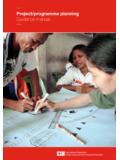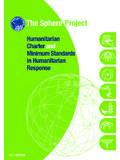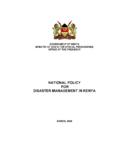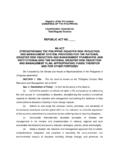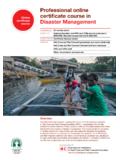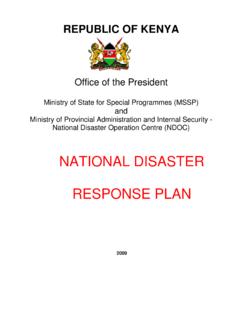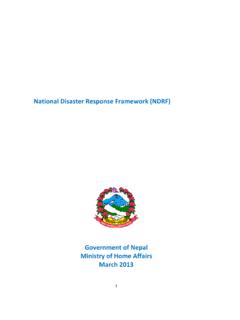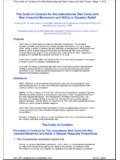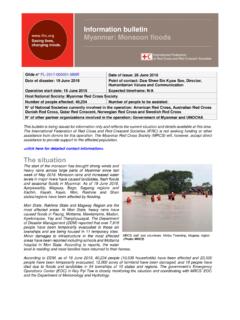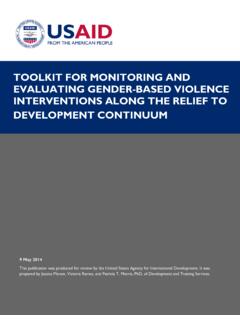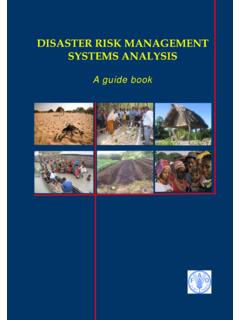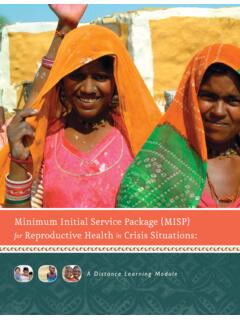Transcription of Minimum standards for protection, gender and ... - ifrc.org
1 Minimum standards for protection, gender and inclusion in emergencies The International Federation of Red Cross and Red Crescent Societies ( ifrc ) is the world s largest volunteer-based hu-manitarian network. With our 190 member National Red Cross and Red Crescent Societies worldwide, we are in every community reaching million people annually through long-term services and development programmes as well as 110 million people through disaster response and early recovery programmes. We act before, during and after disasters and health emergencies to meet the needs and improve the lives of vulnerable people.
2 We do so with impartiality as to nationality, race, gender , religious beliefs, class and political by Strategy 2020 our collective plan of action to tackle the major humanitarian and development chal-lenges of this decade we are committed to saving lives and changing strength lies in our volunteer network, our communi-ty-based expertise and our independence and neutrality. We work to improve humanitarian standards , as partners in development, and in response to disasters. We persuade decision-makers to act at all times in the interests of vul-nerable people. The result: we enable healthy and safe com-munities, reduce vulnerabilities, strengthen resilience and foster a culture of peace around the world.
3 International Federation of Red Cross and Red Crescent Societies, Geneva, 2018 Copies of all or part of this study may be made for noncom-mercial use, providing the source is acknowledged. The ifrc would appreciate receiving details of its use. Requests for commercial reproduction should be directed to the ifrc at opinions and recommendations expressed in this study do not necessarily represent the official policy of the ifrc or of individual National Red Cross or Red Crescent photos used in this study are copyright of the ifrc unless otherwise Box 303 CH-1211 Geneva 19 Switzerland Telephone: +41 22 730 4222 Telefax: +41 22 733 0395 E-mail: Web site.
4 standards for protection, gender and inclusion in emergencies 1 Table of contentsAcknowledgments 2 Introduction 3 Definitions 9
5 Dignity, Access, Participation and Safety (DAPS) 14 Protection, gender , Inclusion and Disaster Law 22 Minimum standards 25 Emergency Health 26 Food Security 36 Water, Sanitation and Hygiene (WASH) 45 Shelter 54 Livelihoods 64 Non-food Items (NFIs) 72 Cash-based Interventions (CBIs) 80 Disaster Risk Reduction (DRR) 89 Annexes 1. Sex, Age and Disability Disaggregated Data (SADDD) 972. Selection and Prioritisation Criteria 1023. The Survivor-Centred Approach in Practice for Healthcare Staff 1062 International Federation of Red Cross and Red Crescent SocietiesAcknowledgementThe International Federation of Red Cross and Red Crescent Societies ( ifrc ) Minimum standards for protection, gender and inclusion in emer-gencies (2018) is in its second edition.
6 The first pilot version of the ifrc Minimum standard commitments to gender and diversity in emergency programming was published in 2015. The pilot version has been tested globally by Red Cross and Red Crescent staff, volunteers and manage-ment in low-, medium- and high-scale disasters and humanitarian crises. The standards have been translated into Arabic, French, Russian and Spanish and adapted to National Red Cross and Red Crescent Societies country edition is the result of three years of testing, revision and feedback from protection, gender and inclusion (PGI) and sectoral specialists.
7 New chapters, such as cash-based interventions, have been added as well as a stronger focus on sexual and gender -based violence and disability inclu-sion to align with the commitments of the ifrc and its member National Societies. This edition is accompanied by the ifrc Protection, gender and inclusion in emergencies toolkit (2018 2019).As a global tool, there have been many people involved in its design, test-ing, revision and finalisation. The ifrc would therefore like to acknowledge all National Red Cross and Red Crescent Societies for their outstanding contributions to this publication as well as ifrc Country Offices, Country Cluster Support teams, Regional Offices and Headquarters staff for their input.
8 Specific acknowledgment goes to the Global gender and Diversity Network, Regional gender and Diversity Networks, the ifrc Reference Centre for Psychosocial Support and the International Committee of the Red Cross (ICRC).A special thanks goes to the Australian Government, Australian Red Cross, Norwegian Red Cross and Swedish Red Cross who contributed financially to the production of these revised standards for protection, gender and inclusion in emergencies 3 Introduction34 International Federation of Red Cross and Red Crescent SocietiesThis guidance presents Red Cross and Red Crescent staff, members and volunteers with a set of Minimum standards for protection, gender and inclusion (PGI) in emergencies.
9 It aims to ensure that the emergency pro-gramming of the International Federation of Red Cross and Red Crescent Societies ( ifrc ) and National Societies provides dignity, access, participa-tion and safety for all people affected by disasters and provides practical guidance on how to mainstream these four principles in all sectors, based on a consideration of gender , age, disability and other diversity factors. This includes limiting people s exposure to the risks of violence and abuse and ensuring that emergency programmes do no harm .The standards address protection, gender and inclusion concerns by providing practical ways to engage with all members of the community, respond to their differing needs and draw on their capacities in the most non-discriminatory and effective way.
10 This helps to ensure that local per-spectives guide assistance delivery. The standards also support incorpora-tion of the seven Fundamental Principles of the International Red Cross and Red Crescent Movement (hereinafter referred to as the Movement ).Putting these standards into practice is one of the key means to implement: the ifrc Strategic Framework on gender and Diversity Issues (2013 2020); 2015 International Conference Resolution 3: Sexual and gender -based violence Joint action on prevention and response; and 2015 Council of Delegates Resolution 4: Strategic Framework on Disability Inclusion in the International Red Cross and Red Crescent Movement.
